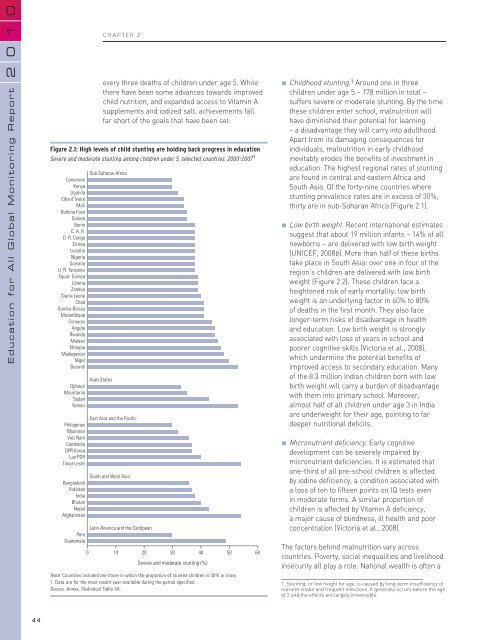Chapter 2. Progress towards the EFA goals - Unesco
Chapter 2. Progress towards the EFA goals - Unesco
Chapter 2. Progress towards the EFA goals - Unesco
Create successful ePaper yourself
Turn your PDF publications into a flip-book with our unique Google optimized e-Paper software.
0<br />
1<br />
0<br />
CHAPTER 2<br />
2<br />
Education for All Global Monitoring Report<br />
every three deaths of children under age 5. While<br />
<strong>the</strong>re have been some advances <strong>towards</strong> improved<br />
child nutrition, and expanded access to Vitamin A<br />
supplements and iodized salt, achievements fall<br />
far short of <strong>the</strong> <strong>goals</strong> that have been set:<br />
Figure <strong>2.</strong>1: High levels of child stunting are holding back progress in education<br />
Severe and moderate stunting among children under 5, selected countries, 2000–2007 1<br />
Cameroon<br />
Kenya<br />
Uganda<br />
Côte d’Ivoire<br />
Mali<br />
Burkina Faso<br />
Guinea<br />
Benin<br />
C. A. R.<br />
D. R. Congo<br />
Eritrea<br />
Lesotho<br />
Nigeria<br />
Somalia<br />
U. R. Tanzania<br />
Equat. Guinea<br />
Liberia<br />
Zambia<br />
Sierra Leone<br />
Chad<br />
Guinea-Bissau<br />
Mozambique<br />
Comoros<br />
Angola<br />
Rwanda<br />
Malawi<br />
Ethiopia<br />
Madagascar<br />
Niger<br />
Burundi<br />
Djibouti<br />
Mauritania<br />
Sudan<br />
Yemen<br />
Philippines<br />
Myanmar<br />
Viet Nam<br />
Cambodia<br />
DPR Korea<br />
Lao PDR<br />
Timor-Leste<br />
Bangladesh<br />
Pakistan<br />
India<br />
Bhutan<br />
Nepal<br />
Afghanistan<br />
Peru<br />
Guatemala<br />
Sub-Saharan Africa<br />
Arab States<br />
East Asia and <strong>the</strong> Pacific<br />
South and West Asia<br />
Latin America and <strong>the</strong> Caribbean<br />
0 10 20 30 40 50 60<br />
Severe and moderate stunting (%)<br />
Note: Countries included are those in which <strong>the</strong> proportion of stunted children is 30% or more.<br />
1. Data are for <strong>the</strong> most recent year available during <strong>the</strong> period specified.<br />
Source: Annex, Statistical Table 3A.<br />
Childhood stunting. 1 Around one in three<br />
children under age 5 – 178 million in total –<br />
suffers severe or moderate stunting. By <strong>the</strong> time<br />
<strong>the</strong>se children enter school, malnutrition will<br />
have diminished <strong>the</strong>ir potential for learning<br />
– a disadvantage <strong>the</strong>y will carry into adulthood.<br />
Apart from its damaging consequences for<br />
individuals, malnutrition in early childhood<br />
inevitably erodes <strong>the</strong> benefits of investment in<br />
education. The highest regional rates of stunting<br />
are found in central and eastern Africa and<br />
South Asia. Of <strong>the</strong> forty-nine countries where<br />
stunting prevalence rates are in excess of 30%,<br />
thirty are in sub-Saharan Africa (Figure <strong>2.</strong>1).<br />
Low birth weight. Recent international estimates<br />
suggest that about 19 million infants – 14% of all<br />
newborns – are delivered with low birth weight<br />
(UNICEF, 2008b). More than half of <strong>the</strong>se births<br />
take place in South Asia: over one in four of <strong>the</strong><br />
region’s children are delivered with low birth<br />
weight (Figure <strong>2.</strong>2). These children face a<br />
heightened risk of early mortality: low birth<br />
weight is an underlying factor in 60% to 80%<br />
of deaths in <strong>the</strong> first month. They also face<br />
longer-term risks of disadvantage in health<br />
and education. Low birth weight is strongly<br />
associated with loss of years in school and<br />
poorer cognitive skills (Victoria et al., 2008),<br />
which undermine <strong>the</strong> potential benefits of<br />
improved access to secondary education. Many<br />
of <strong>the</strong> 8.3 million Indian children born with low<br />
birth weight will carry a burden of disadvantage<br />
with <strong>the</strong>m into primary school. Moreover,<br />
almost half of all children under age 3 in India<br />
are underweight for <strong>the</strong>ir age, pointing to far<br />
deeper nutritional deficits.<br />
Micronutrient deficiency. Early cognitive<br />
development can be severely impaired by<br />
micronutrient deficiencies. It is estimated that<br />
one-third of all pre-school children is affected<br />
by iodine deficiency, a condition associated with<br />
a loss of ten to fifteen points on IQ tests even<br />
in moderate forms. A similar proportion of<br />
children is affected by Vitamin A deficiency,<br />
a major cause of blindness, ill health and poor<br />
concentration (Victoria et al., 2008).<br />
The factors behind malnutrition vary across<br />
countries. Poverty, social inequalities and livelihood<br />
insecurity all play a role. National wealth is often a<br />
1. Stunting, or low height for age, is caused by long-term insufficiency of<br />
nutrient intake and frequent infections. It generally occurs before <strong>the</strong> age<br />
of 2 and <strong>the</strong> effects are largely irreversible.<br />
44
















